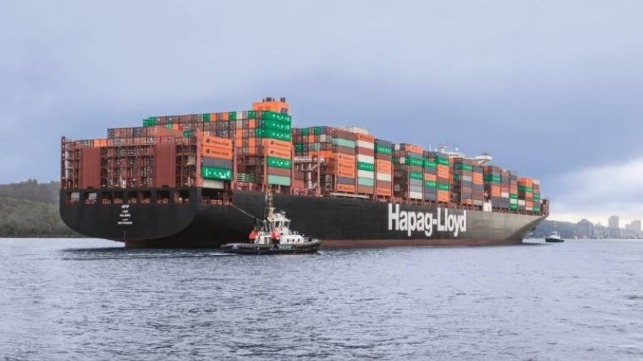Hapag-Lloyd Joins Shipping Industry Move to Green Financing

Hapag-Lloyd has become the latest company in the shipping industry to turn to “green financing,” for its future growth. Increasingly the shipping industry is turning to this innovative form of financing that links the terms of the financing with the company’s ability to achieve measurable targets in sustainability.
“Our first green financings are a major milestone for us, as we are breaking new ground in the container shipping segment by financing newbuilding projects geared towards sustainability. The transactions will help us to modernize our fleet while further reducing our CO2 footprint at the same time,” said Mark Frese, Chief Financial Officer of Hapag-Lloyd.
Hapag said that it has completed a $417 million syndicated green loan with a 12-year maturity. It will be used to finance three of the six 23,500 TEU containerships the company ordered in December 2020. The credit facility is being backed by the Korea Trade Insurance Corporation (K-SURE), and the syndicate consists of 11 banks. An additional $472 million to finance the other three ships in the order was raised through a lease financing agreement structured by the Industrial and Commercial Bank of China Leasing (ICBC Leasing).
Both of the debt transactions fulfill the Green Loan Principles of the Loan Market Association and DNV GL acted as the independent expert providing the second party opinion used for the verification under the terms of the green financing. Hapag said the new vessels’ extremely fuel-efficient high-pressure dual-fuel engines, would be able to reduce CO2 emissions by approximately 15 to 25 percent, providing the basis of the terms meet the requirements of the Green Loan Principles.
The concept of sustainability linked loans has been used by other industries but is now gaining momentum in shipping as the industry works to meet the international goals to reduce its environmental impact. Last week, Japan’s NYK announced that it completed a $50 million Sustainability Linked Loan, the first in Japan denominated in a foreign currency. NYK had previously entered into a sustainability linked Yen-denominated loan in November 2019. Both loans are linked to the sustainability score NYK receives from CDP (Carbon Disclosure Project), an international non-profit organization that reports on corporate performance.
Expanding on the more wide-spread sustainability loans, the Norwegian tanker operator, Odfjell became the first maritime company to complete a sustainability-linked bond offering. In January 2021, the company raised $100 million in an oversubscribed offering that is linked to its efforts to reduce greenhouse gas emissions. Seaspan followed with its own unsecured sustainability-linked bonds. They raised $200 million in the Nordic bond market paying 6.5 percent interest on the bonds that will mature in February 2024.
What makes these financing unique, and is attracting the interest of green investors, is that the financial or structural characteristics vary depending on achieving the selected sustainability performance targets. For example, the interest rate might be adjusted based on the ability to meet the targets while other terms might include margin adjustment, coupon adjustment, or re-payment amount adjustment.
The structure is well suited to industries that have a large environmental impact. Companies that can meet their targets are rewarded while green investors view the structure as encouraging and accelerating environmental efforts with penalties for issuers that do not proceed with the environmental programs and provide verifiable results in meeting their sustainability targets.
